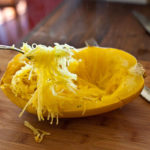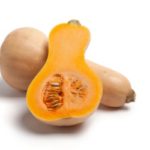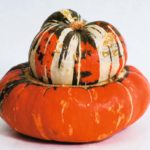The Season for Winter Squash. We know fall has arrived when piles of colourful squash start gathering at the roadside stands. Last year I enjoyed spectacular display at McNabs Farm, where Farmer McNab told me he was growing 100 different varieties of squash, 50 of which were pumpkins, and that he had shopped the world for the seeds. I was quite amazed to discover them sold out by end of the growing season – Canadians sure love their squash!

Spaghetti Squash
We grew a good selection of winter squash on the farm this year – butternuts and buttercups, spaghetti and acorn, red kuri, Turk’s turban, pie pumpkins, sweet dumpling and delicata. They are recognized as a good source of dietary carotenoids thought to provide health benefits in certain cancers and they protect against eye disease.
Winter squash differs from summer squash in that it is harvested and eaten in the mature fruit stage, when the seeds within are fully matured and the skin has hardened into a tough rind. When the squash is ripe it the stalk starts to wither on the vine, a clue that it’s time to harvest. Winter squash has a long storage life, depending on the variety it can keep for up to six months. The ideal temperature for storing winter squash is between 50-60°F (about 10-15°C), so I keep mine inside the house where they look very ornamental piled up in the living room. It’s best to wipe the skin with a damp cloth before curing, which removes any dirt that may cause the squash to rot.

Butternut Squas
Butternut squash is shaped like a large pear and has cream-coloured skin, deep orange-coloured flesh and sweet flavour. Acorn squash has green skin speckled with orange and yellow-orange flesh with unique flavour, a combination of nutty and peppery. Hubbard squash is a large squash that can be dark green, grey-blue or orange-red in colour. The Hubbard’s flavour is less sweet than other varieties.
Turk’s Turban squash is spectacular to behold with green and cream stripes under an orange ‘hat’ and has orange-yellow flesh which tastes of hazelnuts. Kabocha squash is a type of Japanese squash that is becoming very popular due to the sweet chestnut flavour which develops as it cures. It has deep-green skin and orange flesh.
Seeds from winter squash and pumpkins contain healthy oils and make a great snack food when roasted. Scoop the seeds from the squash/pumpkin and place in a single layer on a cookie sheet. Lightly roast at 160-170°F (about 75°C) in the oven for 15-20 minutes. Store in an airtight jar handy for snacking.
To minimize the risk of injury when peeling and cutting, I cut the squash in half with a cleaver, (and a strong arm!) and after scooping out the seeds bake in the oven until just tender (25 minutes). When baked the skin peels off easily and the squash is much easier to cut up. One-inch cubes of squash only need steaming for ten minutes for tenderness and make a perfect accompaniment to many meals.

Turks Head Squash
With squash abundant through the winter months, using it pureed, I am able to prepare lots of pots of spicy warming squash soups. The spiralizer also comes in handy when squash abound, making squash ‘ribbons’ that replace pasta for guilt free eating. Adding cubes of squash to a vegetarian lasagna recipe makes it extra delicious and roasting squash slices sprinkled with cinnamon and drizzled with maple syrup is simply divine. Let us give thanks for the season of squash and Bon appetit!
Carolyn Herriot is a food activist, author, passionate gardener and cook, who believes that healthy eating is the path to healthy aging. She encourages local food security through her books ‘The Zero-Mile Diet’ and has travelled extensively as a lecturer and workshop leader. After operating The Garden Path Centre in Victoria for 25 years she recently relocated to Yellow Point south of Nanaimo, where she has been trying her hand at farming in a rural community. She is currently enrolled as a student at the Canadian School of Natural Nutrition and still writes regularly for local publications under the heading From Farm to Table.
 Carolyn Herriot is author of The Zero Mile Diet and The Zero Mile Diet Cookbook Available at your local bookstore. She grows IncrEdibles! in Yellow Point. www.incredibles.vision
Carolyn Herriot is author of The Zero Mile Diet and The Zero Mile Diet Cookbook Available at your local bookstore. She grows IncrEdibles! in Yellow Point. www.incredibles.vision
See all articles by Carolyn Herriot




Love it!! Thanks so much for sharing your knowledge and enthusiasm!!